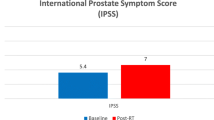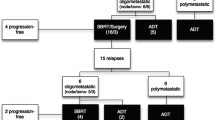Abstract
Objectives
To report preliminary data on feasibility and patient-reported outcomes following PSMA-PET/CT guided SBRT by means of 1.5 T MRI-Linac.
Methods and materials
Between October 2019 and April 2020, twenty consecutive castration sensitive oligorecurrent prostate cancer patients were enrolled in an ethical committee approved prospective observational study (Protocol n. XXXX) and treated with PSMA-PET/CT guided SBRT by means of 1.5 T MRI-Linac (Unity, Elekta AB, Stockholm, Sweden). The mean delivered dose was 35 Gy in 5 fractions. Clinicians reported toxicity was prospectively collected according to Common Terminology Criteria for Adverse Events v5.0. Quality of life (QoL) assessment was performed using EORTC-QLQ C30 questionnaires administered at baseline, end of treatment and at first follow-up.
Results
Twenty-five lesions in 20 castration sensitive oligorecurrent patients were treated: the most commonly treated anatomic sites were nodal (n = 16) and pelvic bone (n = 9). Median PSA-value preMRI guided SBRT was 1.16 ng/mL (range, 0.27–8.9), whereas median PSA value at first follow-up after SBRT was 0.44 ng/mL (range, 0.06–8.15). At first follow-up, for 16 patients showing detectable PSA, PSMA-PET/CT was performed detecting, respectively, in 6 cases partial response and in 10 cases complete response. In the remaining cases, PSA-value was undetectable after SBRT. Radiotherapy treatment was safe and well tolerated according to the PROMs. No acute G2 or higher toxicities were recorded.
Conclusions
The current series represent the largest one exploring the feasibility and patient-reported outcomes following PSMA-PET/CT guided SBRT by means of 1.5 T MRI-Linac. The preliminary findings here reported are encouraging in terms of effectiveness and tolerability.





Similar content being viewed by others
References
Fossati N, Gandaglia G, Briganti A, Montorsi F (2019) The emerging role of PET-CT scan after radical prostatectomy: still a long way to go. Lancet Oncol 20(9):1193–1195. https://doi.org/10.1016/S1470-2045(19)30501-7
EAU Guidelines. Edn. presented at the EAU Annual Congress Barcelona 2019. ISBN 978-94-92671-04-2
Interdisziplinäre Leitlinie der Qualität S3 zur Früherkennung, Diagnose und Therapie der verschiedenen Stadien des Prostatakarzinoms [Internet]. Available: https://www.leitlinienprogramm-onkologie.de/leitlinien/prostatakarzinom/. Accessed 9 May 2018
Calais J, Ceci F, Eiber M, Hope TA, Hofman MS, Rischpler C et al (2019) (18)F-fluciclovine PET-CT and (68)Ga-PSMA-11 PET-CT in patients with early biochemical recurrence after prostatectomy: a prospective, single-centre, single-arm, comparative imaging trial. Lancet Oncol 20(9):1286–1294. https://doi.org/10.1016/S1470-2045(19)30415-2
Mazzola R, Cuccia F, Figlia V, Giaj-Levra N, Nicosia L, Ricchetti F et al (2019) New metabolic tracers for detectable PSA levels in the post-prostatectomy setting: Is the era of melting glaciers upcoming? Transl Androl Urol 8(Suppl 5):S538–S541. https://doi.org/10.21037/tau.2019.12.34
De Bari B, Mazzola R, Aiello D, Aloi D, Gatta R, Corradini S et al (2019) ((68)Ga)-PSMA-PET/CT for the detection of postoperative prostate cancer recurrence: Possible implications on treatment volumes for radiation therapy. Cancer Radiother 23(3):194–200. https://doi.org/10.1016/j.canrad.2018.09.003
Ost P, Jereczek-Fossa BA, Van As N, Zilli T, Tree A, Henderson D et al (2016) Pattern of progression after stereotactic body radiotherapy for oligometastatic prostate cancer nodal recurrences. Clin Oncol (R Coll Radiol) 28(9):e115–e120. https://doi.org/10.1016/j.clon.2016.04.040
Triggiani L, Alongi F, Buglione M, Detti B, Santoni R, Bruni A et al (2017) Efficacy of stereotactic body radiotherapy in oligorecurrent and in oligoprogressive prostate cancer: new evidence from a multicentric study. Br J Cancer 116(12):1520–1525. https://doi.org/10.1038/bjc.2017.103
Fersino S, Borghesi S, Jereczek-Fossa BA, Arcangeli S, Mortellaro G, Magrini SM, Alongi F; Uro-Oncology study group of Italian association of Radiotherapy and Clinical Oncology (AIRO) (2020) PROACTA: a survey on the actual attitude of the Italian radiation oncologists in the management and prescription of hormonal therapy in prostate cancer patients. Radiol Med. https://doi.org/10.1007/s11547-020-01264-1.
Corradini S, Alongi F, Andratschke N, Belka C, Boldrini L, Cellini F et al (2019) MR-guidance in clinical reality: current treatment challenges and future perspectives. Radiat Oncol 14(1):92. https://doi.org/10.1186/s13014-019-1308-y
Cuccia F, Mazzola R, Nicosia L, Figlia V, Giaj-Levra N, Ricchetti F et al (2020) Impact of hydrogel peri-rectal spacer insertion on prostate gland intra-fraction motion during 1.5 T MR-guided stereotactic body radiotherapy. Radiat Oncol 15(1):178. https://doi.org/10.1186/s13014-020-01622-3
De Bari B, Mazzola R, Aiello D, Fersino S, Gregucci F, Alongi P et al (2018) Could 68-Ga PSMA PET/CT become a new tool in the decision-making strategy of prostate cancer patients with biochemical recurrence of PSA after radical prostatectomy? A preliminary, monocentric series. Radiol Med 123(9):719–725. https://doi.org/10.1007/s11547-018-0890-7
Wahl RL, Jacene H, Kasamon Y, Lodge MA (2009) From RECIST to PERCIST: evolving considerations for PET response criteria in solid tumors. J Nucl Med 50(Suppl 1):122S-S150. https://doi.org/10.2967/jnumed.108.057307
Ost P, Bossi A, Decaestecker K, De Meerleer G, Giannarini G, Karnes RJ et al (2015) Metastasis-directed therapy of regional and distant recurrences after curative treatment of prostate cancer: a systematic review of the literature. Eur Urol 67(5):852–863
Ost P, Reynders D, Decaestecker K, Fonteyne V, Lumen N, De Bruycker A et al (2018) Surveillance or metastasis-directed therapy for oligometastatic prostate cancer recurrence: a prospective, randomized, multicenter phase II trial. J Clin Oncol 36(5):446–453
Shankar Siva MB, Murphy DG, Shaw M, Chander S, Violet J, Tai KH et al (2018) Stereotactic ablative body radiotherapy (SABR) for oligometastatic prostate cancer: a prospective clinical trial. Eur Urol 74(4):455–462
Nicosia L, Franzese C, Mazzola R, Franceschini D, Rigo M, Dagostino G et al (2020) Recurrence pattern of stereotactic body radiotherapy in oligometastatic prostate cancer: a multi-institutional analysis. Strahlenther Onkol. 196(3):213–221. https://doi.org/10.1007/s00066-019-01523-9
Mazzola R, Francolini G, Triggiani L, Napoli G, Cuccia F, Nicosia L et al (2020) Metastasis-directed therapy (SBRT) guided by PET-CT 18F-CHOLINE versus PET-CT 68Ga-PSMA in castration-sensitive oligorecurrent prostate cancer: a comparative analysis of effectiveness. Clin Genitourin Cancer S1558–7673(20):30191–30199. https://doi.org/10.1016/j.clgc.2020.08.002
Phillips R, Shi WY, Deek M, Radwan N, Lim SJ, Antonarakis ES et al (2020) Outcomes of observation vs stereotactic ablative radiation for oligometastatic prostate cancer: the ORIOLE phase 2 randomized clinical trial. JAMA Oncol 6(5):650–659. https://doi.org/10.1001/jamaoncol.2020.014
De Bruycker A, Tran PT, Achtman AH, Ost P; GAP6 consortium. Clinical perspectives from ongoing trials in oligometastatic or oligorecurrent prostate cancer: an analysis of clinical trials registries. World J Urol. 2020. https://doi.org/10.1007/s00345-019-03063-4.
Jereczek-Fossa BA, Bortolato B, Gerardi MA, Dicuonzo S, Arienti VM, Berlinghieri S, Bracelli S, Buglione M, Caputo M, Catalano G, Cazzaniga LF, De Cicco L, Di Muzio N, Filippone FR, Fodor A, Franceschini D, Frata P, Gottardo S, Ivaldi GB, Laudati A, Magrini SM, Mantero E, Meaglia I, Morlino S, Palazzi M, Piccoli F, Romanelli P, Scorsetti M, Serafini F, Scandolaro L, Valdagni R, Orecchia R, Antognoni P; Lombardy Section of the Italian Society of Oncological Radiotherapy (Associazione Italiana di Radioterapia Oncologica-Lombardia, AIRO-L). Radiotherapy for oligometastatic cancer: a survey among radiation oncologists of Lombardy (AIRO-Lombardy), Italy. Radiol Med. 2019 Apr;124(4):315–322. https://doi.org/10.1007/s11547-018-0972-6
Winkel D, Werensteijn-Honingh AM, Kroon PS, Eppinga WSC, Bol GH, Intven MPW et al (2019) Individual lymph nodes: “See it and Zap it.” Clin Transl Radiat Oncol 30(18):46–53. https://doi.org/10.1016/j.ctro.2019.03.004
Winkel D, Bol GH, Werensteijn-Honingh AM, Intven MPW, Eppinga WSC, Hes J et al (2020) Target coverage and dose criteria based evaluation of the first clinical 1.5T MR-linac SBRT treatments of lymph node oligometastases compared with conventional CBCT-linac treatment. Radiother Oncol 146:118–125. https://doi.org/10.1016/j.radonc.2020.02.011
Chow E, Meyer RM, Ding K, Nabid A, Chabot P, Wong P et al (2015) Dexamethasone in the prophylaxis of radiation-induced pain flare after palliative radiotherapy for bone metastases: a double-blind, randomised placebo-controlled, phase 3 trial. Lancet Oncol 16(15):1463–1472. https://doi.org/10.1016/S1470-2045(15)00199-0
Dunlop A, Mitchell A, Tree A, Barnes H, Bower L, Chick J et al (2020) Daily adaptive radiotherapy for patients with prostate cancer using a high field MR-linac: initial clinical experiences and assessment of delivered doses compared to a C-arm linac. Clin Transl Radiat Oncol 29(23):35–42. https://doi.org/10.1016/j.ctro.2020.04.011
Mazzola R, Figlia V, Rigo M, Cuccia F, Ricchetti F, Giaj-Levra N et al (2020) Feasibility and safety of 1.5 T MR-guided and daily adapted abdominal-pelvic SBRT for elderly cancer patients: geriatric assessment tools and preliminary patient-reported outcomes. J Cancer Res Clin Oncol. 146(9):2379–2397. https://doi.org/10.1007/s00432-020-03230-w
Alongi F, Rigo M, Figlia V, Cuccia F, Giaj-Levra N, Nicosia L et al (2020) 1.5 T MR-guided and daily adapted SBRT for prostate cancer: feasibility, preliminary clinical tolerability, quality of life and patient-reported outcomes during treatment. Radiat Oncol. 15(1):69. https://doi.org/10.1186/s13014-020-01510-w
Cuccia F, Mortellaro G, Mazzola R, Donofrio A, Valenti V, Tripoli A, Matranga D, Lo Casto A, Failla G, Di Miceli G, Ferrera G (2020) Prognostic value of two geriatric screening tools in a cohort of older patients with early stage Non-Small Cell Lung Cancer treated with hypofractionated stereotactic radiotherapy. J Geriatr Oncol 11(3):475–481. https://doi.org/10.1016/j.jgo.2019.05.002
Cuccia F, Fiorentino A, Corrao S, Mortellaro G, Valenti V, Tripoli A, De Gregorio G, Serretta V, Verderame F, Ognibene L, Lo Casto A, Ferrera G (2020) Moderate hypofractionated helical tomotherapy for prostate cancer in a cohort of older patients: a mono-institutional report of toxicity and clinical outcomes. Aging Clin Exp Res 32(4):747–753. https://doi.org/10.1007/s40520-019-01243-1
Author information
Authors and Affiliations
Corresponding author
Ethics declarations
Conflict of interest
Filippo Alongi is a speaker and consultant for Elekta; Ruggero Ruggieri is a consultant for Elekta. All the other authors have no conflict of interests.
Ethical standards
All procedures have been approved by the appropriate ethics committee and have therefore been performed in accordance with the ethical standards laid down in the 1964 Declaration of Helsinki and its later amendments.
Additional information
Publisher's Note
Springer Nature remains neutral with regard to jurisdictional claims in published maps and institutional affiliations.
Rights and permissions
About this article
Cite this article
Mazzola, R., Cuccia, F., Figlia, V. et al. Stereotactic body radiotherapy for oligometastatic castration sensitive prostate cancer using 1.5 T MRI-Linac: preliminary data on feasibility and acute patient-reported outcomes. Radiol med 126, 989–997 (2021). https://doi.org/10.1007/s11547-021-01352-w
Received:
Accepted:
Published:
Issue Date:
DOI: https://doi.org/10.1007/s11547-021-01352-w




